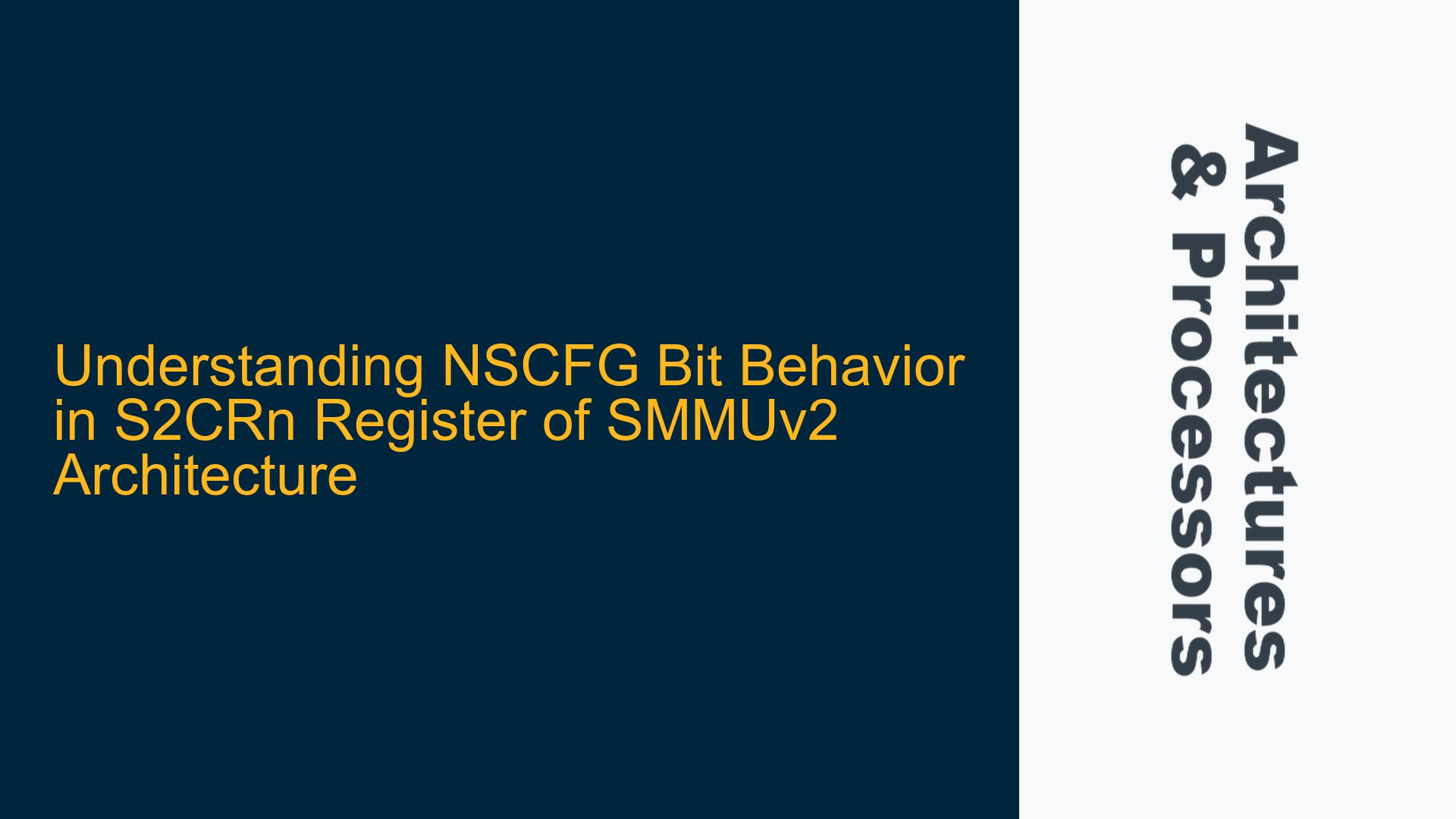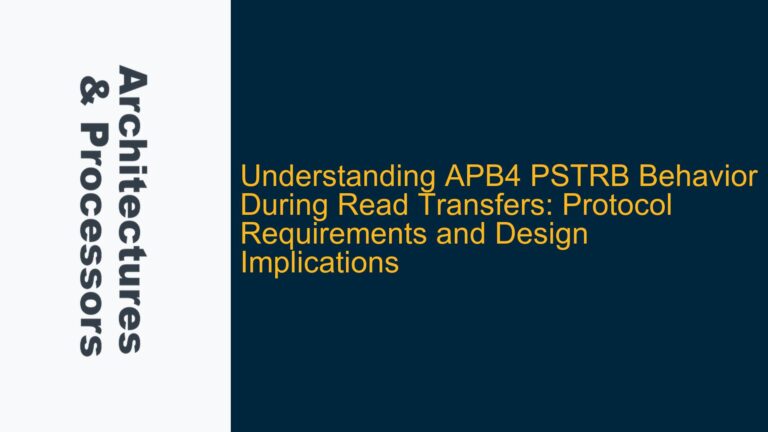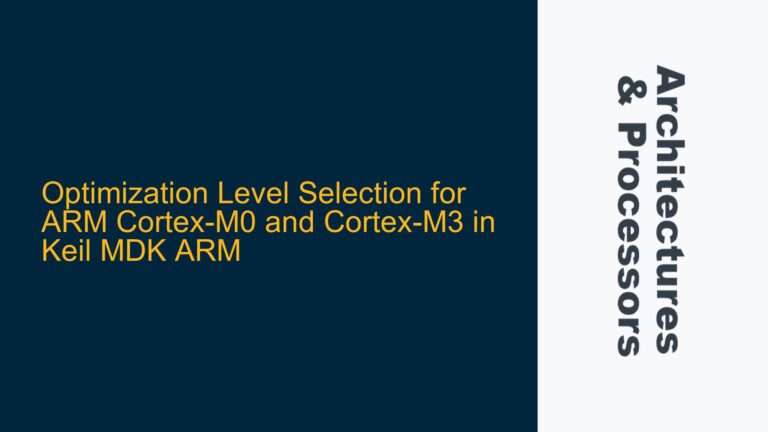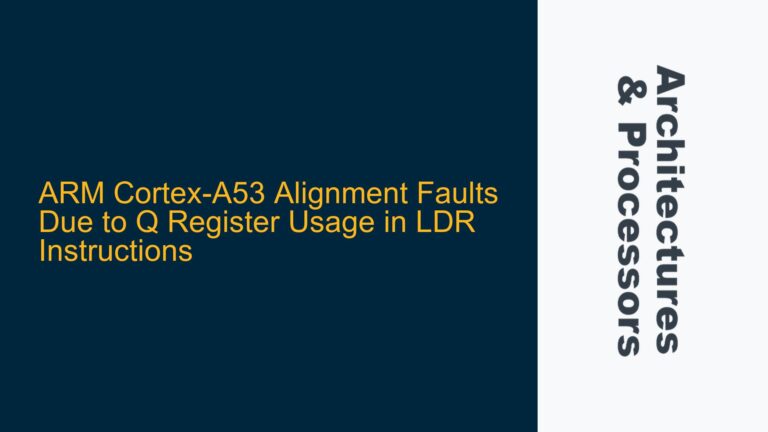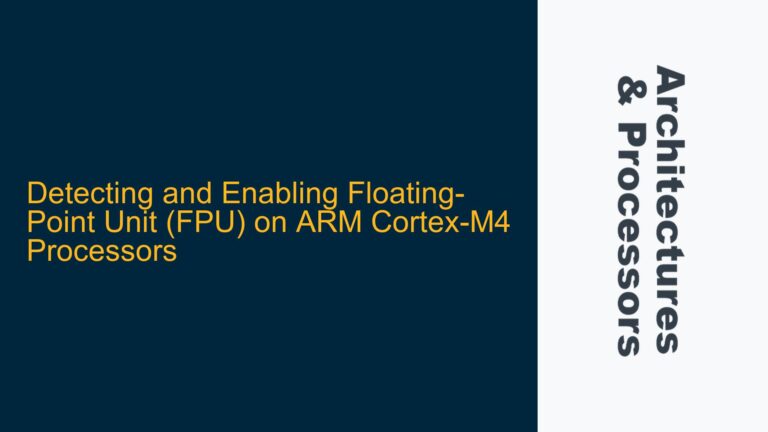NSCFG Bit Functionality in S2CRn Register and Its Impact on Translation Table Walks
The NSCFG (Non-Secure Configuration) bit in the S2CRn (Stream-to-Context Register n) register of the SMMUv2 (System Memory Management Unit version 2) architecture plays a critical role in determining the security state of translation table walks. When the NSCFG bit is set for a specific Stream ID, it influences whether the SMMU performs translation table walks in the Non-Secure (NS) state. This behavior is analogous to the NSTable bit in the page table, which also dictates the security state of memory accesses. However, the interaction between the NSCFG bit and the NSTable bit, as well as their combined impact on the translation process, requires a detailed examination to fully understand their functionality.
The SMMUv2 architecture is designed to handle memory transactions from multiple peripherals, each identified by a unique Stream ID. The S2CRn register, which is part of the SMMU’s configuration space, contains several fields that control the translation behavior for a given Stream ID. Among these fields, the NSCFG bit is particularly significant because it directly affects the security state of the translation process. When the NSCFG bit is set, it forces the SMMU to perform translation table walks with the NS bit set, effectively treating the translation tables as Non-Secure. This behavior is crucial in systems where both Secure and Non-Secure worlds coexist, as it ensures that the SMMU adheres to the security policies defined by the system architect.
The NSCFG bit’s behavior can be compared to that of the NSTable bit in the page table. The NSTable bit, which is part of the page table descriptors, determines whether a specific page table entry should be treated as Non-Secure. When the NSTable bit is set, the SMMU will treat the corresponding memory region as Non-Secure during the translation process. However, the NSCFG bit operates at a higher level of abstraction, influencing the security state of the entire translation table walk for a given Stream ID. This distinction is important because it allows system designers to enforce different security policies at different levels of the translation hierarchy.
In summary, the NSCFG bit in the S2CRn register is a powerful tool for controlling the security state of translation table walks in the SMMUv2 architecture. When set, it forces the SMMU to perform translation table walks with the NS bit set, effectively treating the translation tables as Non-Secure. This behavior is similar to that of the NSTable bit in the page table, but operates at a higher level of abstraction, allowing for more granular control over the security state of memory transactions.
Potential Misconfigurations and Their Impact on System Behavior
The NSCFG bit’s behavior in the S2CRn register is straightforward when considered in isolation, but its interaction with other configuration bits and system-level security policies can lead to subtle issues if not properly understood. One of the primary concerns is the potential for misconfigurations that could result in unintended security breaches or system instability. For example, if the NSCFG bit is set for a Stream ID that is intended to access Secure memory, the SMMU will incorrectly treat the translation tables as Non-Secure, potentially allowing unauthorized access to Secure memory regions.
Another potential issue arises from the interaction between the NSCFG bit and the NSTable bit in the page table. If both bits are set, the SMMU will perform translation table walks with the NS bit set, and the resulting translations will also be treated as Non-Secure. However, if the NSCFG bit is set but the NSTable bit is not, the SMMU will still perform translation table walks with the NS bit set, but the resulting translations may be treated as Secure or Non-Secure depending on the NSTable bit’s state. This inconsistency can lead to unpredictable behavior, especially in systems where the security state of memory regions is critical.
Additionally, the NSCFG bit’s behavior can be influenced by other configuration bits in the S2CRn register, such as the CFG (Configuration) bit, which controls whether the SMMU performs translation table walks at all. If the CFG bit is not set, the SMMU will bypass translation for the corresponding Stream ID, regardless of the NSCFG bit’s state. This can lead to situations where the NSCFG bit appears to have no effect, even though it is set correctly. Therefore, it is essential to ensure that all relevant configuration bits are set appropriately to achieve the desired behavior.
In systems where multiple Stream IDs are used, the NSCFG bit’s behavior must be carefully coordinated across all Stream IDs to ensure consistent security policies. For example, if one Stream ID is configured to access Secure memory and another is configured to access Non-Secure memory, the NSCFG bit must be set differently for each Stream ID to enforce the correct security policies. Failure to do so can result in security vulnerabilities or system crashes, as the SMMU may incorrectly treat Secure memory as Non-Secure or vice versa.
In conclusion, the NSCFG bit’s behavior in the S2CRn register is highly dependent on the configuration of other bits and the overall system security policy. Misconfigurations can lead to unintended security breaches, system instability, or unpredictable behavior. Therefore, it is crucial to carefully consider the interaction between the NSCFG bit and other configuration bits, as well as the overall system security policy, when configuring the SMMUv2 architecture.
Best Practices for Configuring NSCFG Bit and Ensuring Correct System Behavior
To ensure correct system behavior and avoid potential issues related to the NSCFG bit in the S2CRn register, it is essential to follow a set of best practices when configuring the SMMUv2 architecture. These best practices include understanding the interaction between the NSCFG bit and other configuration bits, carefully coordinating the NSCFG bit’s behavior across multiple Stream IDs, and thoroughly testing the system to ensure that the desired security policies are enforced.
First and foremost, it is crucial to understand the interaction between the NSCFG bit and other configuration bits in the S2CRn register. As previously discussed, the NSCFG bit’s behavior can be influenced by other bits, such as the CFG bit, which controls whether the SMMU performs translation table walks at all. Therefore, it is essential to ensure that all relevant configuration bits are set appropriately to achieve the desired behavior. For example, if the NSCFG bit is set to enforce Non-Secure translation table walks, the CFG bit must also be set to enable translation for the corresponding Stream ID.
Second, it is important to carefully coordinate the NSCFG bit’s behavior across multiple Stream IDs to ensure consistent security policies. In systems where multiple Stream IDs are used, each Stream ID may have different security requirements, and the NSCFG bit must be set differently for each Stream ID to enforce the correct security policies. For example, if one Stream ID is intended to access Secure memory and another is intended to access Non-Secure memory, the NSCFG bit must be set to 0 for the Secure Stream ID and to 1 for the Non-Secure Stream ID. Failure to do so can result in security vulnerabilities or system crashes, as the SMMU may incorrectly treat Secure memory as Non-Secure or vice versa.
Third, it is essential to thoroughly test the system to ensure that the desired security policies are enforced. This includes testing the system under various conditions, such as different memory access patterns, different security states, and different configurations of the NSCFG bit and other configuration bits. Testing should also include scenarios where the NSCFG bit is set differently for different Stream IDs, to ensure that the SMMU correctly enforces the desired security policies for each Stream ID.
In addition to these best practices, it is also important to consult the SMMUv2 architecture documentation and any relevant errata or application notes provided by the processor vendor. These documents may contain additional information or recommendations for configuring the NSCFG bit and other configuration bits, as well as any known issues or limitations that may affect the system’s behavior. By following these best practices and consulting the relevant documentation, system designers can ensure that the NSCFG bit is configured correctly and that the SMMUv2 architecture operates as intended.
In conclusion, configuring the NSCFG bit in the S2CRn register of the SMMUv2 architecture requires a thorough understanding of its interaction with other configuration bits, careful coordination across multiple Stream IDs, and thorough testing to ensure that the desired security policies are enforced. By following these best practices and consulting the relevant documentation, system designers can avoid potential issues and ensure that the SMMUv2 architecture operates correctly in their systems.
